For a total of $34 US, I hired a tuk-tuk driver, who will be at my disposal for the next three days, carrying me back and forth between my modern, elegant hotel and the ancient temple ruins, located six kilometers north of town. Initially I thought the entire ruin complex was named Angkor Wat but I have discovered that Angkor Wat is the name of just one of the temples – perhaps the most famous one – in this massive city that was built beginning in 889 AD. The complex is so large that it requires a minimum of three days to see just the most important structures (frankly, a person could spend a year investigating these ruins, visiting a different site each day, and still not see them all). I have been told that there are countless sites yet to be excavated and, indeed, I did see numerous unexcavated mounds with carved blocks poking out from the surrounding dirt.
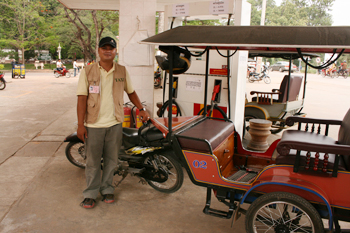
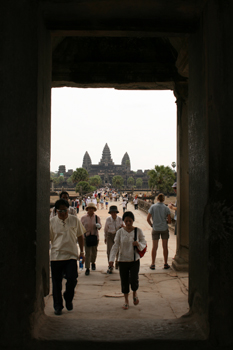
Because Angkor Wat is the best known among the temples, it was my first stop. My initial view of it was through the stone doorway of the wall surrounding the temple, its three signature spires punctuating the morning haze. It took my breath away. I stood stunned, unable to move, as I took in its beauty. When I finally got my senses back I stepped over the stone portico and onto the long stone walkway leading to the temple itself. Built between 1113 and 1150 AD, Angkor Wat is the largest religious monument in the world and it is truly extraordinary. Although volcanic laterite blocks were used as underlayment to provide structural strength, the majority of Angkor Wat was constructed of sandstone blocks that were intricately fitted together to form the scalloped, pointed towers for which it is so famous. The sandstone, being relatively soft, proved the perfect material for the artisans of the time, who decorated the walls, ceilings, pillars – practically every available space – with breathtaking carvings of geometric designs, gods and goddesses, scenes from everyday life and scenes from both Hindu and Buddhist religious legends, such as this long stone mural (below) depicting the ancient Hindu legend of the Mahabharata.
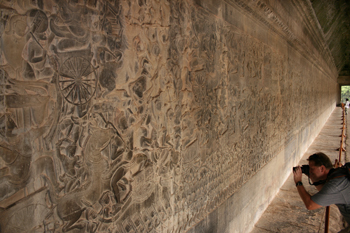
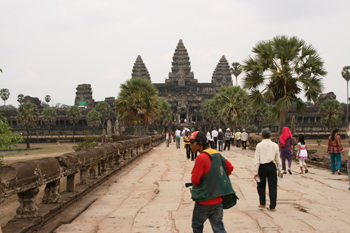
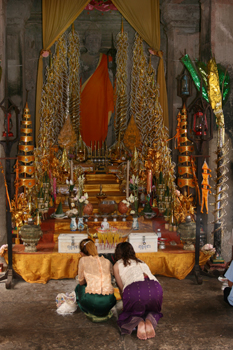
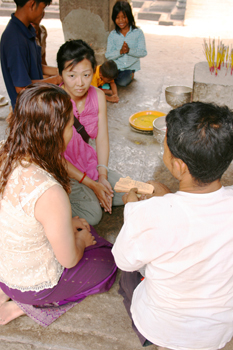
Once inside I wandered the lower levels. In one of the inner buildings I happened upon an altar decorated in vivid gold and red, its requisite pot of burning incense sticks on the floor in front of the stone Buddha. Two Thai women, dressed in their finest long silk skirts and lace tops, prostrated themselves before the altar three times, praying for, perhaps, a fortunate marriage or the blessings of a male baby. At the right side of the altar another woman held a dog-eared set of long, thin cards over her head, while an old man chanted and prayed. He then had the woman select a card and, from it, told her fortune. An interpreter sat between client and diviner, translating what the old man said as the client listened respectfully. Fortune telling has a long tradition in South East Asia and to this day, even at the highest levels of government, astrologers and diviners are consulted before any major decisions are made.
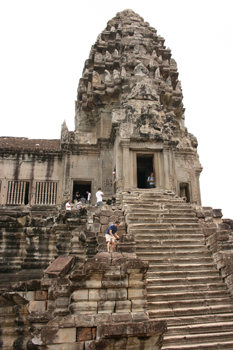
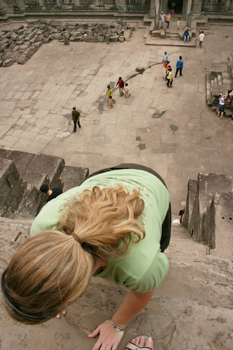
To really appreciate the beauty and engineering of Angkor Wat, one must climb to the very top. I stood at the bottom of the main stairway, contemplating the daunting climb up the steep, narrow stairway. I watched people half my age struggle to negotiate the steps, wondering whether I could handle the nearly vertical climb. Since falling down a 60-foot cliff some years ago, I am not always comfortable with heights, especially where there are no guard rails. Sure, I could go up – but would my bad knee be able to make it back down again without giving out? What would I do if I got half way up and froze? Worse yet, what if I got to the top and then was unable to get back down again? Would they feed and clothe me for the rest of my life as I sat, cross-legged and meditating, at the top? Lord hates a coward, I thought, and up I went. I hugged the right side, taking one deep step at a time, pulling myself up by grasping the giant sandstone blocks that border the stairway. I did not look down until I reached the top – then I made the mistake of leaning over the edge to see how far up I had come. It was so steep that I could not see the bottom. OK – stay in the moment, I thought. Time to worry about getting down later.
The view from the top is simply stunning. From inside one of the signature towers I looked down upon the entire Angkor complex and miles of the surrounding countryside.
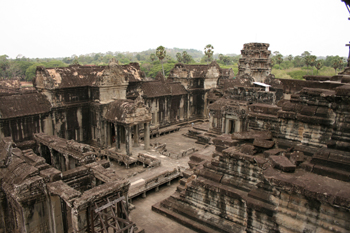
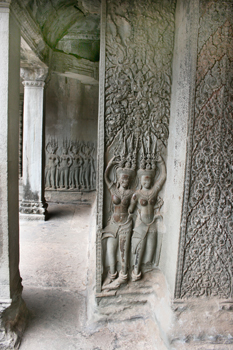

I looked across the abyss to see a line of people slowly and carefully picking their way along a sandstone ledge that hovered on the edge of a precipice, in order to gain access to the next tower. I wandered from room to room, snapping photos of ancient carvings that covered every surface. Unconcerned parents allowed their children to dart in and around pillars and climb up and down the crumbling stairs without concern for their safety.
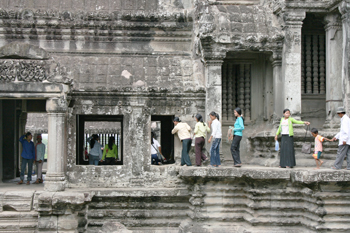
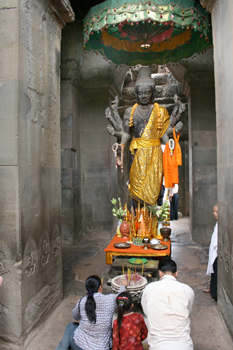

In the very upper reaches of the towers I happened upon yet another altar with a huge stone Buddha statue adorned in saffron robes, where a family of three knelt in prayer while the old nun who attended the altar looked on. Finally, when I’d had my fill, I started to look for a way down and discovered an alternative set of stairs on another side of the temple, where someone had the foresight to install a metal railing. Here, people were lined up to descend – very few hardy souls braved the descent on the stairs where I had ascended. I waited for my turn, watching with fascination the various methods of descent employed by the people in front of me. Some clutched the hand of their guide the entire way down. Some went down facing forward. Others went down backwards. A couple of people went down on their bums, sliding from one step to the next. Next I started looking at the feet of the people in line and I couldn’t resist snapping these two shots – one of Cambodian people who live at the level of the red dirt that makes up this country, and the other of a group of well-heeled tourists. When it was my turn, to my delight, I practically bounded down the stairs, stopping at the bottom to snap this shot of the line of tourists as they came down the stairs.

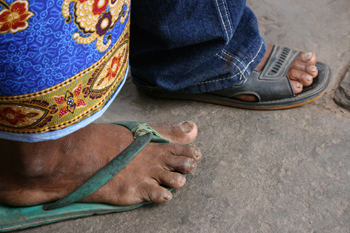
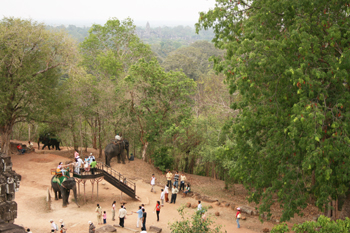
After a mid-afternoon break to escape the heat, I returned to the ruins at 4PM to visit Phnom Bakheng. Phnom means mountain in Khmer (the national language of Cambodia) and Bakheng is the name of the mountain. At one time there was a massive temple on this site. Much of it lies in ruins today but it is still a popular place from which to view the sun as it sets, casting its golden light on the temple complex below. I discovered that I could either walk up the mountain or make the climb on the back of an elephant – I opted for the latter. I was enjoying myself immensely until I turned around to take a photo of the elephants coming up the trail behind me, carrying their human cargo. I watched in horror as the mahout (the elephant handler) behind me encouraged his elephant to walk faster by prodding it in the forehead with a pointed metal rod. I said a fervent prayer and asked forgiveness of my elephant. I would swear he looked at me with sorrowful eyes as I dismounted. I promise that I will never, ever, ride another elephant.
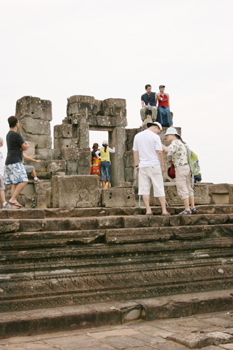
The top of Phnom Bakheng was another disappointment, littered as it was with tourists who were climbing all over the priceless antiquities without regard for the damage they were doing. I even saw one couple climb to the top of stone doorway so they could get the best possible view of the sunset. People pushed and shoved and I was jostled several times by rude tourists who rushed to get a better position. The energy here was so bad that I left early – there was not much chance of a sunset anyway, with the day’s overcast weather. I think the sunsets are best saved for Angkor Wat anyway, which is situated such that the setting sun turns the sandstone to gold on clear afternoons.
Finally, exhausted from the heat and seriously in need of a shower, I called it a day. I made the 1200 year journey between the ancient ruins and Siem Reap, with its five star hotels and modern infrastructure, in a matter of minutes. It was a bit like stepping out of a time machine.

I was in Cambodia in September with my daughter. Phnom Penh and Siem Reap/Angkor Wat were my destinations. Thank goodness my trip went much more smoothly than yours! I have lived in Asia before (South Korea) and had read about the corruption and the begging, among other things. I had also read NOT to take that trip into Cambodia overland from Thailand. I wasn’t planning on doing it but my daughter, who was there doing research for her Master’s thesis, was going to risk an overstay of her visa by a week. The solution to that was to get a visa renewal at the local tour guide’s hole-in-the-wall for $35, guaranteed back the next day. Smile and pay. Then there is the exit fee at the airport–cough up $25 to leave the country. Total racket. I loved the Angkor Wat area, however, and would love to go back. One thing I did find out from our “English-speaking” tuk-tuk driver was that the park workers are paid $1 a day. Considering the park takes in $20 a day per tourist, someone is making huges amounts of money. No surprise there.
Anyway, I haven’t been to Thailand but that is my next destination. Thank you for your interesting blog, by the way.
Thank you, Just me. So glad you liked it. I am soon headed back to Cambodia,
this time to Sihanoukville, Battambang and Phnom Penh. Despite the problems
at the border and the obvious corruption, I loved Cambodia and its smiling,
wonderful people, as much as I love Thailand. Wishing you a fabulous trip.
Hey there I sumbled upon your webpage by accident, I was digging around Yahoo for Hawaii Flooring when I came upon your blog, I must say your webpage is really intriguing I just love the layout, its amazing! I’m in a bit of a rush at the moment to completely absorb your website but I have bookmarked it and also subscribed for your RSS feeds. I will be back when I have more time. Thank you for a great website.